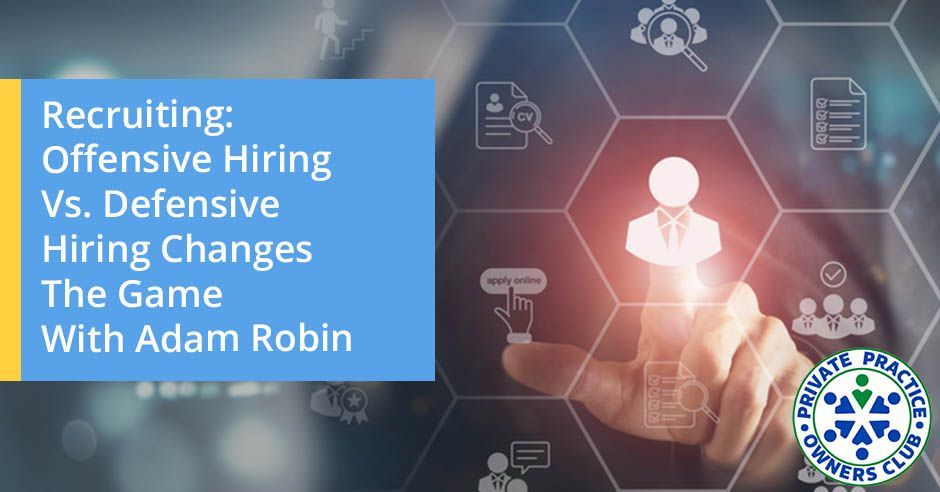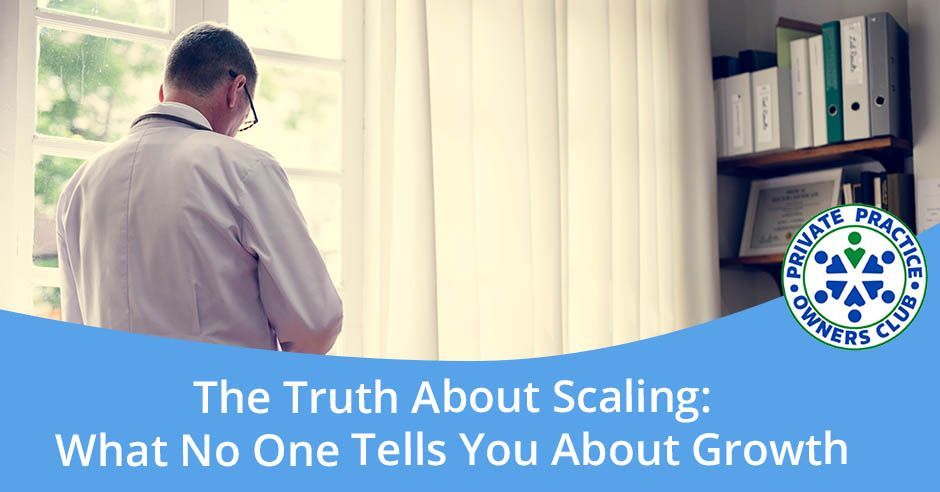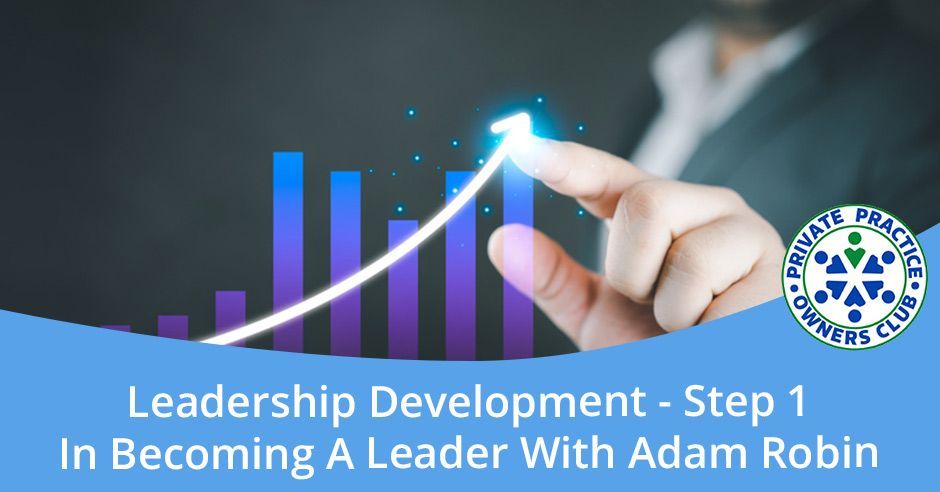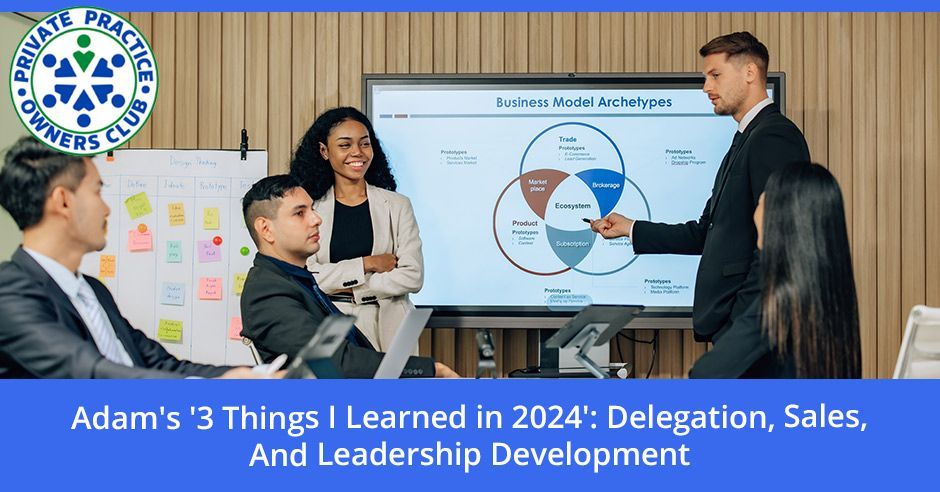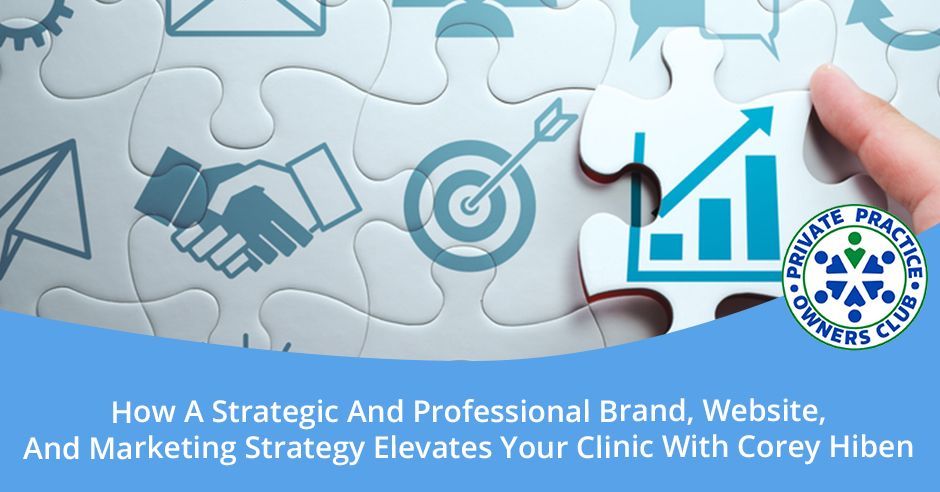Leadership Development, Expansion, and Growth - Practice Owners Manual Series, Part 9
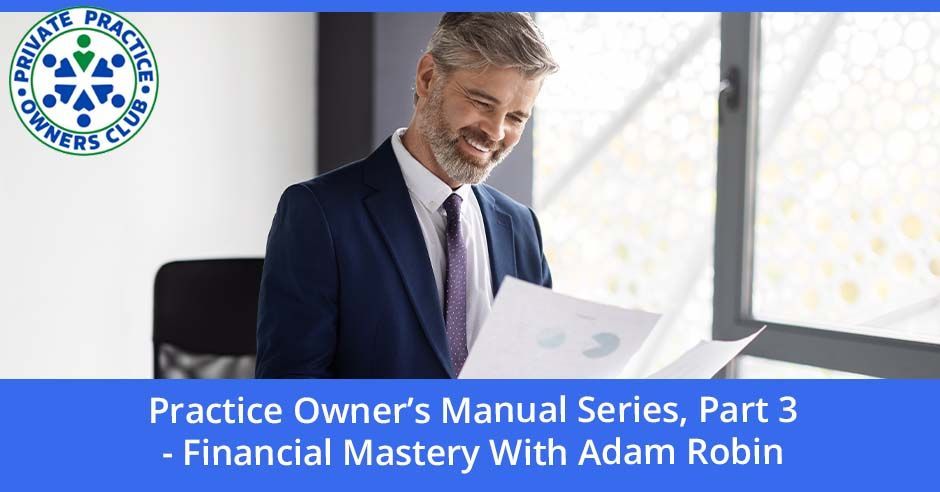
Join Nathan and Adam into the world of growth and leadership development as they unpack the critical elements that can take your practice to the next level. This episode is a goldmine of actionable insights that you can't afford to miss if you're considering expanding your practice or honing your leadership skills.
This episode will serve as your ultimate roadmap to Practice expansion. From establishing robust policies and procedures to cultivating a powerhouse leadership team, Nathan and Adam discuss it all. Uncover the secrets to identifying potential leaders within your team and learn the essential steps to groom them into the catalysts behind your practice's triumph.
Here are some of the episode highlights:
- Find out why a policy-driven organization outshines a people-driven one.
- Learn how to spot top-performing individuals in your team.
- Gain practical advice on crafting a leadership development program.
- Delve into the real challenges of Practice growth and discover how to conquer them.
Don't miss Leadership Development, Expansion, and Growth - Practice Owners Manual Series, Part 9" – it's packed with valuable insights for private practice owners!
Want to talk about how we can help you with your private practice, or have a question you want to ask? Book a call with Adam - https://calendly.com/adamrobin/dr-adam-s-30-minute-connection
Love the show? Subscribe, rate, review, and share! https://ppoclub.com/
--
Listen to the podcast here
Leadership Development, Expansion, and Growth - Practice Owners Manual Series, Part 9
Welcome back to the next episode in our series of the quintessential Bulletproof Practice Owner's Manual for Success. Hopefully, you appreciated the previous episode, took lots of notes, and did some homework. Now, get ready to do some more work on your business. Get out pad and paper, and let's go.
---
We are on our final episode of the Practice Owner Manual series. This is episode number 10 of that series, part 9. This episode's focus is on growth and expansion/leadership development. Adam, this is awesome. Thanks for coming in again.

Happy to be here.
You've read for several episodes up to this point, hopefully. You've gotten to this point laying out a foundation for your company, and you have some solid pieces in place. You've got some processes in place. You've got the 1) Written down and 2) You're following through on them. You've got other people following through on them with you.
You went through a lot of the basics and whatnot. You're thinking, “I've got this opportunity. I've got such and such building has a vacancy now. It's a perfect part of the city. There's a ton of traffic. I want to open up over there, and I've got to do it now.” We're going to talk about whether you should or not, essentially. This is what we're going to talk about.
Hopefully, you've gotten a lot of value from the previous episodes. We'll wrap a bow on this one, and I'm sure we can add more to it as we get down the road and as we get feedback from you guys about what more you'd like to hear about. We'll focus on these ten for now and package them for you. I mentioned in the first episode that we did with these that Adam's going to be putting these together in a special package for members of our clientele, our coaching clients, and making it part of our vault.
Adam has built out a huge, robust vault. Congratulations, by the way, Adam. That's pretty awesome. This is for people who are looking for all the specific risks of the things that we've mentioned, all the nuts and bolts and details, the job description, the templates, the name that can help with your policy and procedure creation, and how you interact with your team.
He's put a ton of that together in our vault that is available to our coaching clients, and this is going to be a big part of taking people from startup to the growth and expansion phase. Congratulations on putting this all together, Adam. This is going to be a big part of that. As we're looking at growth and expansion, I think one of the things we want to talk about first, correct me if we should start from a different tact here, is looking at developing our leadership in your team. Do you want to start there, or do you want to go where somewhere else?
Importance Of Leadership Development
If you haven't listened to the previous episodes, then I think that's where you start. This is going without saying and we'll get into that, but you have a marketing plan in place. You have policies and procedures. They're ringing right ineffectively. You're hiring. You have a hiring process. You have all the recruiting systems down. All those things are done for the they're done. They're complete. They're efficient, and you're not doing all of them. I think leadership is a good place to start.
We've banged the gong a lot about policy, procedures, and creating SOPs and job descriptions. Those things are very helpful in making sure that your clinic is running based on policy and not by people. A
policy-run organization is a much more effective and productive organization than a people-run organization because a people-run organization is going to be dependent upon the people.
Whether or not they want to work today, if they're productive, or their opinions versus what needs to be done versus a policy-run organization, which is run by policy no matter who's there running it. That can be effective, efficient, and consistent, you name it. Building out leaders then, on top of that, is an essential role in your expansion.
It is because, at some point, you move up in the organization and see yourself on the organizational chart. Moving to the next box up above it and not filling in all the boxes down below from janitor to front desk operator, then requires you to build out some leadership, some teams of leaders that can do some of this work, and you can delegate some of these issues to people.
One of the things that we've talked about in the past that helped me a lot is that a lot of people don't know where to start. I want to have a leader on my team. Maybe that person is a leader over the front desk personnel. Maybe that's a leader over the clinic director per se, but where to start is, “Do I just give them the title and send them off on their way?”
That's what I would have done in the past kick them out of the nest and say, “Here, figure out how to fly.” A much better way is to be a little bit more intentional about leadership development and growing leaders on your team. One of the first things that I like to consider when I'm considering leaders is, “I have my core values in place and I have some productivity metrics. Who are some of the people on my team that pretty well follow our values and align with our purpose all the time.”
They do a good job with it. They fit into the culture. They work well with others. The business is better because they're there. I would enthusiastically hire them again if they came before me. They're good at producing. Producing is not a concern of theirs. That's the first place I would start. Tell me what you're thinking of as you're thinking of how to differentiate and find those initial leaders in your company.

Identifying And Cultivating A-Players
I think that's exactly right. That's perfect. Just imagine, you're in the clinic and something terrible happens. Maybe not too terrible, but something that's just disruptive. It's not fitting into my schedule. There's one person that you're going to call. Who are you going to call? That's probably your leader. Right?
The person who's just dependable. They show up. They're consistent. They're dialed in. I have always liked to use this vertical axis and its value alignment. On the horizontal, it's production. You want people who are maximally value-aligned and maximally productive. Those are A players. The upper right quadrant. Those are the people who are going to get it done, and they're bought into the culture.
As it pertains to growth and expansion, it's hard to do that without those types of people on your team.
It's impossible. There's only so much heavy lifting that you can do by yourself. Heavy lifting means doing the hard things, making the hard decisions, doing the hard things, and putting in the hard hours. You can't do that all by yourself forever, maybe one clinic, maybe, but not two. You'll need somebody who wants to pick that boulder up with you, who's picking that one up and saying, “I got you.”
At some point, you became the hurdle To the company. Yes, you're the weak link, honestly. That's what's interesting: people will say that, but they don't believe it because they want to think that
they're the exception to the rule. I've got it all the time, but I don't have the money. I know all the answers, and it's easier for me to just do it myself than to have someone else do it.
Good luck with that.
That will not last long. What do you say to people who might be saying, “What if I don't have any of those people on my team right now?”
You got to find them. I would say that you probably have the wrong people on the bus. There was a time when we were coaching me, and I had it all in place. I've got two or three PTs on my team. I had my front desk. I thought I had it all in place, but I had enough in place to where I was happy. I'm ready to start thinking about clinic number two, but we weren't growing. We weren't growing. We were just stagnant. I was like, “Nathan, what's going on?” “What do I need?”
You said something that hit me and you said, “Your PTs just aren't that good. Sounds like you just need some better PTs.” That resonated with me. I realized, “My gosh. I don't have anybody on my team who can help me in that capacity.” I have a bunch of staff people on my team. Guess what? I had to go recruit and find an A player and replace them. That process unlocked so many possibilities. I went and found two A-player PTs, hired them and opened up two more clinics.
Go back and listen to thelast episode about recruiting and hiring and the one before that about hiring and onboarding. Focus on that if you don't have those people on your team right now because that's one of the reasons why we were always hiring. We always had an add-up for all of our positions. We are always going through that process simply because the best way to grow is to get a bunch of A players. The best way to stay stagnant and not go anywhere is to tolerate C players.
The best way to grow is to assemble a team of A players, while the best way to stay stagnant is to tolerate C players.
You'll stay in business, but it won't be fulfilling. You'll have a culture that you don't enjoy. You'll have people around you who you don't enjoy spending the majority of your life with because you're there eight to ten hours a day. Go out and recruit and find some more people. Honestly, it's a hard pill to swallow because that's a lot of work. It is a lot of work, but if you have aspirations for hire, it hit me when I heard it the first time and I say it all the time.
The people who have gotten you here are not the people who will get you there. You have to replace them. Even the good ones. What I found is the ones like the front desk people who stuck with me when I was at 50 visits a week. I grew to a 150 and I wanted up a second clinic. I started implementing policies and procedures on how things should get done. When I didn't have that structure in place, that person who I swore by that I would live, breathe, and die with and wanted to be on my team for the rest of my life.
When they got to 150 and they started seeing changes, that person was expendable. They couldn't follow the policy and procedure, acted out, and didn't follow the values. That just speaks to the people who got you here, not those who will get you there. You need newer skill sets. You need greater capabilities.
You need to develop leaders. The sooner you do it, the sooner you'll be able to grow and expand well. It is because as you find those people who are value-aligned, buy into the culture, help you establish the policy and procedure, lead out on the team, and are looking to produce and do more with you, those are the people who are going to lead you to further growth and expansion.
That's right. If you've done or implemented everything up to this point, you should have a team of clinicians. They're fairly productive. You've got a clinic that's growing. It's profitable. Everybody's pretty organized. At some point, it's time for you to start stretching your team. That came from a mentor of mine. Your job is to stretch. Your job is to get results that are not average to people.
Your job is to get extraordinary results out of people. Help them become the best versions of themselves. They have to be willing to do hard things. If you want to find out who wants to be an A player and who doesn't, start stretching them a little bit, and they'll quickly tell you who wants to step up to do it and who doesn’t.
Your job as a leader is to get extraordinary results from people and help them become the best versions of themselves.
Yes, because the default is, if I've got this experienced PT who's got, maybe some managerial experience over other PTs, has been a clinic director in the past and is super productive and just assuming that they're going to be great in this managerial capacity in your company, you're leading yourselves to a potentially huge problem.
They could be great, but they need to learn how you do things in your company. How you lead others in your company could be different than what they came with. Now, what they came with and experienced in the past, you're by all means welcome to bring that forward and say, “We did this over here and I think that worked rather well.”
Do you want to do that here? Yes or no? Then that's up to you as the leader to say, “I appreciate that, but I see it this way and I'd rather do it this way.” You appreciate that experience and their experience in brainstorming and bringing solutions to the table, but you still need to be the ultimate determinant. Sometimes, a good B player who is productive is not the best leader. Some people are meant to be worker bees and just want to be worker bees.
They can do that, but we're talking about growth, expansion, and moving forward. Those people could have a place on our team, but it was understood that they weren't going to go anywhere that their responsibilities outside of treating patients or running the front desk were not much. Maybe they were more superficial about leading out on the charity drive or the birthdays, making sure everyone got a birthday card on their birthdays.
They had other responsibilities that weren't necessarily leadership roles. There are those people and that's the default. If I'm going to find a leader, I need to find that person who has a ton of experience and is super productive. That's not true. It starts with, “Are they value aligned?” One of my best clinic directors was a PTA.
She grew up with me in a small clinic. I don't know why, but she was super loyal to me. She stayed with me through all the hard lessons that I had to learn and all the crap that I put her through. Once we gave her some structure. She was a great clinic director. They could produce. It was amazing because she wasn't the best PTA. She was a productive PTA, but her skills weren't necessarily there. She was a great leader and people loved her. There are those people that you've got to find. They just don't default to the most productive and most experienced persons. I guess that's what I'm trying to say.
I would say my experience working with owners is it's usually that one clinician who's just rock solid. You have a training in place. They're helping you train other therapists. They're helping you keep them productive. They're almost acting like a director. They're helping you lead out on a team meeting. They're active.
That person, whoever that is in your practice, and then, very much likely that front desk person who just got the whole front desk figured out. They're maybe helping you train other front desk people. Maybe they're helping you with payroll. They're helping you with your account. They have access to some of the personal things that maybe not everybody has access to.
Those two people, that's your first leadership team. It's you and those two. You have your administrator and then you have your client director. It’s like, “This is the inner circle. This is the leadership team. Step 1, let's establish a meeting rhythm where we can start talking about things outside of the team meeting, some of the bigger topics, some of the bigger plans, and having that leadership meeting outside of the regular team meeting.
Creating A Leadership Development Program
When you're looking at leadership, we talked about onboarding two episodes ago. You need to consider that coming into a leadership position like this also requires onboarding. I've mentioned this numerous times in past episodes, but the last thing you want to do is give somebody a title and the salary bump, and then start training them.
That's the wrong way around. For us, the clinic director meant that there was an agreement. We decided on this person. They agreed with us. “I want the path to leadership.” “Great.” We're going to put you in the leadership development program. While you're in the leadership development program or at least at some point during the leadership development program, we're going to give you the title of clinic director and trainer. No salary increase, but you're going to start learning what it means to be a leader in our clinic.
That includes this leadership program which might be reading some books that we agreed to. I think we've done a full episode on this before because this sounds familiar. Looked back somewhere in the last eight months or I'm pretty sure we've done something like this. Read some of the same books that were influential to the owner. Here are some of the trainings.
Here are some of the meetings that were expected. Maybe give them some homework. Lead out on a meeting. Here's a problem in the clinic right now. Bring to me two or three solutions for how you would handle it. Here's a charity drive. Do you want to lead that out? Give them some opportunities to lead. Watch how the team follows them or not. Let them implement solutions and walk them through it.
This is where you become the coach. I'm coaching you to become a leader. How are you going to handle this when and is not productive? What are the KPIs that you're going to track? How often are you going to track them? How are you going to report them to me, your supervisor, your direct report? Developing a leadership program is the next stage.
Once you've identified that person, they've been on your team, and you've noticed they're value-aligned and productive. Now, you engage them in onboarding to leadership through your leadership development program. It doesn't have to be long and exhaustive, but you have to be able to have them show themselves that they are leaders in some capacity with a little bit of coaching.
Absolutely, and you've got it. There are nine episodes of material to pull from. Talk about your purpose and values. What does it mean, why is it there, and why do we have a sales process? What does it mean, and why do we market it? What is marketing? What's the onboarding and hiring process? What is the policy and procedure? How do we do it? How do we do a team meeting? This is how we lead it this way.
You want to create a mini CEO. Somebody who's a mini version of yourself and who's inside that clinic can think and act similarly to you. Maybe they're not the true CEOs, but they can behave as if they are the CEO of their world. They need to know those things. I remember doing not my first clinic director training but the second one.
Once I polished it up nicely, it was cool to hear them say, “This is awesome. I understand why we do some of the things that we do now.” We talked about this in the meeting that we had with our team just before this. Once they understood the purpose and how this all fits into the big picture, the buy-in and the drive that they had. They owned it. Just helping them see that and then coaching them through how to apply it to their day-to-day. Six months later, you have a great leader who can help you do some of the heavy lifting.
That is my next question. How long do you think a leadership development program should take? It's individualized because some people might catch on a little bit faster. Maybe they have some experience in holding people accountable or the KPI metrics, your dashboard, and whatnot. What are your expectations in terms of that leadership development program, and how fast do they get through it?
Six to twelve months.
It's up to them.
Yes. I think it's the way that we do. It's self-paced. We don't push any type of checklist that things have to be done in a certain time frame. It's self-paced and we try to incorporate ways that they can improve the culture. Be proactive about improving the culture. Identify one way that one gap that you see in our culture and create a plan to help improve it.
What a great assignment. You want to get them thinking about, “How do I get my team happy?” What a great assignment. I would probably write that down. That's a great thing for you to do with them. You can't create cultural problems. Those are things that just happen organically, and it's hard to put the time into them.
How much do you pay them for that stuff?
I don't pay anything. I think that we should just block off a little time on their calendar so they can start meeting with us individually and we can start having real authentic conversations about that stuff.
There has to be some point before they get into this leadership development program that they've expressed the desire to become a leader in your company. You also equally want them to become a leader in your company. You are going to set aside some time for them, but the pace at which they get through the program is essentially dependent upon their desire. You can't force that upon anybody.
If they want to get through it quickly, great. If they want to take their time, maybe there are some external factors. One thing you have to recognize that might kick somebody out of that program is their inability to follow through on things they're committed to. Their inability to garner attention, the commitment of other team members, inability to follow through, and inability to communicate with team members in a positive, productive, and uplifting way.
Maybe their solutions to problems are different. Maybe they're outside of what you would expect. Maybe they don't represent the values or how you exactly want to get things done. Have you ever had to usher someone off of the leadership development track? What were some of the things that they were doing that led you that way?
Just a lack of focus.
A lot of excuses.
A lot of lack of significance to the importance of why the program is there. Those are indications that some people just don't want to grow with you.
This goes back to the reason why we give them the clinic director in training title without the salary bump because of this right here. If things go awry, it's easy to take off that in-training portion or the clinic director in-training title and just put them back where they were before without creating some upset where you essentially have to let them go. You don't want to embarrass them in that regard. That's exactly why we did it that way.
Core Responsibilities Of Leadership
There are three main products of the leadership team. 1) Is going to be developing an unmatched patient experience. 2) Is facilitating a thriving company culture, and 3) is going to be growing profitability. That's your job as a leader. That's your job in this company. Whether you're a director, a director of admin, or a director of recruiting, your attention should be on one of those three things. If not, all of them. It takes a it takes a CEO mindset to do that. It's not an employee mindset. Those are two different things.
Exactly, someone who takes ownership of their position, whatever it is at the time. Thinking back to when you opened your 2nd clinic, do you think you needed to have that clinic director in place or were you able to get by without it?
No. I had to have it in place.
Some form of policy and procedure as well.
Yes. Some form of accountability. I would assume that it's probably possible to do it without it. Probably not going to be fun. It's probably going to be way more challenging. Huge headache but one of the greatest paths to getting wealthy or successful is your ability to learn how to let go. That was a quote shared by a mentor of mine.
One of the greatest paths to wealth or success is your ability to learn how to let go. You can only truly let go if you have people you trust who have demonstrated their ability to handle the heavy lifting with you.
The only way you'll be able to let go is if you have people you trust who have demonstrated the ability to do the heavy lifting with you. If you don't have that, you're going to find yourself gripping way too tightly to things that you shouldn't be any longer and you're just going to be divided. You're going to be stretched. You're not going to be able to be effective as a leader in your company.
It’s one thing for you to be able to drive production. One of the growth statistics that I often reference is your utilization rate. You want it to be above 85%. Utilization rate is the number of appointment slots that you have on your calendar across all providers compared to how many are filled during the week.
You want that percentage of filled slots to be 85% above average. Especially looking at bringing on another provider or going to another clinic, as a whole, you want that to be 90% if you can, but at minimum 85%. You also have to consider financials. That clinic that has that utilization rate is maximally profitable. Now, there are other things to consider.
You might want to open the second clinic, but if you want to push the maximum productivity out of certain square footage, then you take that square footage divided by 10%, which is your average PT visit per week. This depends on demographics, but like in New York, where it's super tight, these people blow that ratio out of the water.
If you have a 2,000 square foot clinic, 10% is 200. Your max capacity is about 200 visits per week. Then you also know it's probably time to grow. Find more space, move on, and get another bigger space, or find a second. Those are some of the growth KPIs to go off of. To go back to my point, it's one thing for you as the owner to drive those productivity numbers and get that production.
It's a second thing with a completely different skill set to have someone who's not the owner drive those numbers and hold them where they need to be while you're looking to grow and expand. That's what we're talking about here leveraging others to continue to improve production and thrive where it's not you. It is because if you're looking at a second location specifically.
You're going to be tied up in the construction of it, the lease negotiations, the equipment purchases, and hiring team members for that second clinic, getting them trained up and onboarded. Maybe you're pulling from the other clinics, so you have to train them for the first clinic. All of those things are going to be required of you, at least at this stage. To do that while you're also trying to maintain productivity at the first clinic is just a lot.
Scaling And Expanding The Business
Yes, it's impossible. I think it's cool to hear that. Being able to lead your team is like level one of leadership or maybe level two, but being able to lead a person who can lead the team requires another level of leadership from you. You've got to be more clear and more explicit. You can't show up and cuss everybody out at the team meeting. You can't be all stressed out. You got to be able to listen more and there are a lot of leadership skills that you have to be able to develop. Being able to get that kind of work done through people requires something different from you.
I think that's especially necessary for that second clinic. Now, as you get to a 3rd and a 4th clinic and you've experienced this, that's where you've started developing an even greater leadership team now maybe you have a marketing person, maybe you have someone in they're full-time or part-time, maybe you have a recruiting person or a person over HR and maybe they're part-time or full time, and you have a clinic director in place and you have higher level meetings.
Now, you can start handing some of these things off to your leadership team. When you have a couple of clinics underneath you start having them help build out that 3rd and 4th clinic as you grow further. We're talking right now just about the germination of that leadership team. This is where it starts when you're starting to think about growing up as an organization, transitioning from Mom and Pop to enterprise, if you will.
Not everything is run according to Nathan, but everything is run according to policy and procedure. We follow standard operating procedures and we don't just ask Nathan for all the answers. Let's get out of that as soon as possible. When you're able to do that, you tell me, but that's when you probably saw a level of freedom in your first clinic when you had a clinic director and maybe a couple of PTs underneath it.
Maybe you hit that magic four or five-provider mark that seems optimally profitable. You take on some greater purpose as an owner. You also develop another skillset, but you also develop a different level of freedom to where now you're separating yourself so much further away from the day-to-day and just working exclusively with your leadership team.
Yes. The way that I like to recall that experience in my head was my unit of measure used to be patient visits per week. Once, I had that first clinic operating without me being there, and I had a director. I had a leader there. I wasn't in the team meeting anymore, but I was able to go all in on my stats, my pro forma, and my financials. See on a deeper level how things worked from a metric standpoint. Then my unit of measure became, I have a clinic. I have another clinic and I have another clinic. I was able to zoom out a little bit further as a leader and see how the big picture was.
The percentage of productive clinics.
Yes, the vision expands. “Look at this unit.” Once you develop that, step one, having that leadership team, how do I create a pro forma? How do I create this again? The pro forma, the policies, the procedures, the systems. Create a playbook on how to create that so I can I can package number two.
You have some of that for clients, don't you? Are you in the vault?
Absolutely. I do.
Of course you do. They don't have to figure this out by themselves.
However, the game becomes different. Now, you're playing the real game of being an owner. The real game of being an owner is not hiring, firing, and all that stuff. The real game is opening and expanding your business. That's the real game, and I don’t know what everybody else is playing. Welcome to the real game.

I think you might have had a different mindset than me, but I could never have imagined back when I was treating patients, starting my clinic, and even when I was getting 100 to 150 visits a week. That was my goal. Initially, if I could get two providers at 150 visits a week, that would be like a dreamland. I was in La La Land. Maybe I had a PTA or two and whatever, but that's all I needed.
I would constantly tell myself, “If I'm just treating patients this in the future and having to deal with all the business stuff, I'm going to get burned out quickly. I need to find someone who runs the business for me so I can just treat patients all the time.” Could you have ever imagined that you would be so far away from the point that you are? I never even thought that something could replace my passion for patient care.
Yes, you grow.
Did you have some of that?
Yes. I can't put a whole lot of words to it right now, but I think I've experienced this journey of, “I want to open a clinic.” “If I just had a clinic that was mine, my gosh. That would be amazing.” Then, you do that and you're just treating and then as you learn, grow, evolve, and see more possibilities, your perspective changes.
Your purpose changes and you start seeing, “What if I could do this?” “What if I could do that?” It just keeps going and going. It's like, “What if I had two clinics?” “What if I had three?” “What if I had ten?” “What if I started a coaching company?” “What if I was coaching others?” You could keep challenging yourself. You keep seeing new possibilities for yourself.
I opened up my clinic 22 years ago, almost 23 when this episode comes out, and I would have never imagined I'd be where I am right now. It’s just crazy. I bring that up because this is what we're talking to people about with the podcast and why we put together this series of ten episodes regarding the practice owner manual series and how to build a successful clinic is because there is much more.
PT owners can be much more and do much more than they are. They just need a little bit of guidance. As I told you in the last few episodes, you have to get a coach or consultant of some kind. If you’re reading this and you haven't reached out to us or someone else, I don't care. You have to have some kind of support and guidance because there is much more on the other end of this, on the other side of things.
Yes. You could be a PT all your life and that'd be great. Frankly, let me tell you the truth. I don't personally see a lot of fulfilled 60 and 70-year-old PTs out there who are still treating patients full-time. There's so much more to it. If you're an owner, that allows you to see new visitors, create new things, build new skill sets, and even find a different purpose is what I found. I've got a completely different purpose than I did twenty years ago.
There's so much more to be fulfilled, and that's where coaching and consulting have to become a part of it. It's as simple as just reaching out. Book a call with us, book a call with Adam, no strings attached. We'll help you with your pain points and help you out through that call, but you need to find someone. You need to find someone to help. Especially with the pressures that we have in the industry at this point, inflationary pressures, upward pressures, and the downward pressures of reimbursement, you have to have someone who can help you navigate through that stuff.
I agree. Not only that, you have to want it. A lot of people say that they want to be an owner until it's time to do owner stuff.
A lot of people say they want to be an owner until it's time to do the work that comes with ownership. You have to truly want it!
I've got sons who want their businesses, and when we tell them what they need to do, a month later, we ask, “How did you do?”
I'm still thinking about it. Still putting it.
Yes, still thinking about it. “We gave you the flyers that you need to pass out. Did you pass any out?” “I'm not sure.” Yes, you got to want it. You can't make excuses.
I want to just package this up for our manual creators, if that's okay, because you have your pen and paper out. It's chapter ten. It's growing and scaling. Under that step one is development, assuming you have everything else in place and everybody's productive. You have some type of leadership development process in your clinic, such as identifying A players on your team and pushing them through a leadership development process via the books that you've read and the things that you've learned.
Ideally, somebody who can help you on the clinical side and the administrative side such that you can completely exit. You don't have to treat any patients anymore. You could write that down. It doesn't have to be complicated. We've referenced so many books in this show. Name four or five books that were influential to you and build a program around them. From there, you can start managing your practice more remotely and more hands-off by taking a much deeper dive into the statistical performance of your practice.
How do I manipulate the production and operationalize what I'm looking for in that practice to create the profit margins that we need? From there, you can create a playbook on how to copy what you've created and paste it into multiple locations. From there, you can train people on the playbook and then you can further exit the practice, but that's the true game of growing and scaling your practice.
Exactly. Coming from experience, this is the best way to do it. I opened a second location too early before, and I'm surprised that it thrived the way I did, but I’ve invested in the right person. I went on a wing and a prayer, but I gave them zero support. It almost crashed and burned, but I was thankful that person pulled it through. Shout out to Will Humphreys. This is the best way to do it. If you want to survive some headaches and grow in a substantial and fulfilled way, that's not leading to a ton of stress, anxiety, and stress on your family and marriage. This is a good way to do it. The best way to do it.
Yes. Even if you get a coach, it's going to be hard.
Reach out to us, Nathan@PTOClub.com, Adam@PTOClub.com. Let us know what you think about the series. As I said, if you think there are other topics that we might have missed, we thought it might be pretty comprehensive, but of course, there might be holes in it. Thanks for going through this journey with me, Adam. It's been good to cover all this stuff, and hopefully, it's valuable to people who are reading out there. Appreciate it, dude.
For sure. It was cool. Maybe we'll think of some other ideas, and we'll do them.
That’s correct. Thanks, man.
Alright, brother.
Important Links
- Adam Robin
- The 5 Buckets Of Recruiting - Practice Owners Manual Series Part 8
- Nathan@PTOClub.com
- Adam@PTOClub.com
- https://Calendly.com/adamrobin/dr-adam-s-30-minute-connection
About Adam Robin

I am a driven dreamer. I like to think big and take on fun, exciting, and sometimes scary challenges. I like to walk up to the base of the mountain, rally my troops, and take on the climb.
The greatest discovery that I’ve ever made is that my passion for growth tends to rub off on people who also aspire to achieve and create. Once I discovered this everything changed for me…
Since my discovery, I’ve founded and scaled 3 businesses in the healthcare industry. I’ve also developed an online business coaching presence where I empower healthcare practice owners to create freedom and fulfillment in their lives both personally and professionally. I pour my passion, energy, and lessons into everybody that I meet in hopes that they can experience, just a piece of, the personal growth and development that I’ve experienced along my ownership journey.
Lessons that have helped me:
- Become a better father
- Become a better husband
- Become a better friend
- Serve more people





